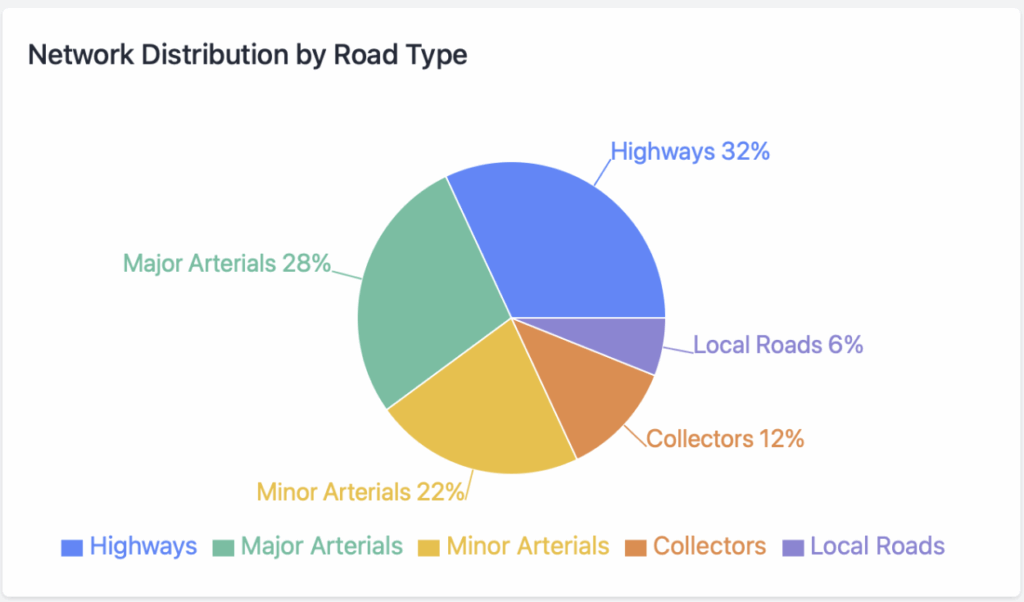The Problem with Traditional Traffic Forecasting
Sravanth Potluri, a Research Assistant at DDS and a University of Virginia master’s student partnered with UVA students Michael Jerge and Shreejeet Sahay to predict DC traffic jams before they happen. Traditional forecasting fails because it treats roads as isolated segments rather than interconnected systems, analyzing historical speeds on individual streets based solely on that street’s patterns while ignoring how traffic cascades through the network. In reality, the system works like a spider web. When an accident blocks one road, effects ripple through surrounding blocks as drivers seek alternate routes, creating a domino effect that impacts entire neighborhoods. Understanding this complex web of interactions requires first examining the underlying infrastructure that makes up DC’s transportation network, as shown in Figure 1 below, which illustrates the composition of DC’s road types.

Figure 1: Network Distribution by Road Type
A Graph-Based Approach to Traffic Networks
Sravanth and his team reimagined DC’s road network as a mathematical graph with intersections and road segments becoming “nodes” connected by “edges” representing physical roads. This graph structure allows AI to understand relationships between network parts, recognizing that highways feed into major roadways and that problems in one location cascade to connected areas. They then applied STGformer (Spatiotemporal Graph Transformer) to teach computers how traffic flows interact across this interconnected system, combining graph neural networks that excel at networked data with Transformer models that identify patterns in sequential data over time.
Leveraging Data
The research leverages DDS’s extensive dataset of 20 million traffic reports from Waze users (2021-2025) covering 280,000 nodes and road segments throughout DC, creating a digital twin of DC’s road network that captures real-world traffic behavior at an unprecedented scale. The model predicts traffic conditions up to an hour ahead with remarkable precision, achieving 86% accuracy in explaining speed variations network-wide. Even when forecasting a full hour, predictions remained highly accurate (81%), typically missing actual speeds by just a few miles per hour.
Model Performance
Performance varies by time and location, the system excels during predictable periods like late night or midday, while evening rush hours (3-7 PM) present greater challenges due to unpredictable incidents. Minor arterials yield more accurate predictions than busy intersections where multiple routes converge. This sustained accuracy provides sufficient warning for traffic control centers to adjust signals, emergency services to reroute vehicles, and commuters to modify travel plans.
Beyond Traffic Jams
Applications extend far beyond helping commuters avoid delays. Combining traffic predictions with accident data could forecast high-risk crash zones, enabling preventative measures like deploying police to potential hotspots before incidents occur. Emergency services could integrate traffic predictions with dispatch systems helping ambulances and fire trucks identify optimal routes in real time. When a cardiac arrest call comes from a neighborhood during rush hour and the system predicts building traffic, dispatchers receive alerts to send units from alternate directions, saving critical minutes. City planners could also model “what-if” scenarios, examining how a new bus lane on major roadways might affect parallel routes or how construction projects impact neighborhood congestion, enabling data-driven infrastructure decisions based on quantitative analysis.
A Data-Driven Future
This project demonstrates the transformative potential of combining machine learning with data. Sravanth Potluri and his team proved it’s possible to analyze an entire city’s traffic patterns and achieve results that make differences in daily life. We’re approaching a future where traffic isn’t unpredictable but something cities can forecast and manage, with advanced warnings and targeted interventions. Better predictions enable better decisions, whether planning your commute, responding to emergencies, or designing infrastructure. This supports DDS’s mission of making streets safer and more efficient through data-driven insights. As cities become increasingly complex, understanding and predicting network effects becomes crucial. This traffic model provides a roadmap for applying similar techniques to other urban challenges, creating more efficient, well-functioning, and adaptive communities.
– DDS

Leave a Reply